Now & New
- Eat
Kure Gourmet Festa: Dedicated to Naval Curry Nationwide
Almost every attraction in Kure has something to do with the Imperial Japanese Navy or the Japan Maritime Self-Defense Force (JMSDF), thus almost every tourist that sets a course for Kure goes to see something nautical. Japanese naval history runs deep and possesses a multitude of facets, including onboard cuisine, the most famous of which is 海自カレー (かいじかれー – Kaiji Curry), which literally means “Sea Self Curry,” referring to the seaside self-defense troops’ Friday shipboard meal. Kure, being one of the five principal naval districts of modern Japan, has perfected its own version of the ubiquitous recipe, and even those who have and want nothing to do with the JMSDF flock here to try this military meal. As a result, restaurants selling Kaiji Curry abound in the city center, and anyone who can eat beef and/or pork but doesn’t have any Kaiji Curry while in Kure ought to be court-martialed.
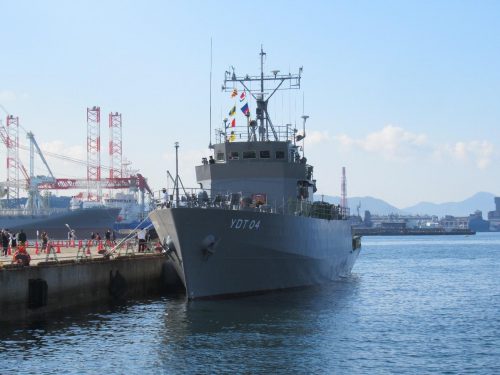
In an attempt to exhibit the glory that is Kaiji Curry, the city of Kure puts on the Kure Gourmet Festa, a local food festival wherein a plethora of restaurants—including eateries from all over Japan specializing in Kaiji Curry—set up shop by the jetty at Kure Harbor. Out of the 48 stores being represented on the 23rd of October this year, exactly half of them are curry shops, with the other half selling snacks, drinks, dessert, and other miscellaneous entrées. The event runs from ten o’ clock in the morning to three o’ clock in the afternoon, and throughout the day there are performances by the JMSDF as well as other locals aiming to improve Kure’s PR. In addition, a YDT-04-class diving support vessel (pictured above) is docked by the harbor so visitors can explore a real JMSDF ship and get a feel for a sailor’s everyday environment.
Landing at the Jetty
I wanted to reach the festival site before the event officially began, to maximize my time enjoying the festivities as well as to avoid the onslaught of tourists that would arrive later in the day. It would seem that at least a few hundred others had the same idea as I did, for by the time I reached Kure Station, descended the stairs to the Yamato Museum, and walked along the red-brick wall to the entrance of the Kure Gourmet Festa, I was about to be submerged in a wave of people. As per COVID-19 prevention measures, all guests were asked to scan the QR code to complete a short survey (those without smartphones would instead fill out a paper survey on a clipboard) before having their temperature taken and stepping into line. Event staff with tall picket signs indicated the end of multiple queues where I was to start lining up, and the queues didn’t start moving until the clock approached 10:00 a.m. and they started letting us into the event site.
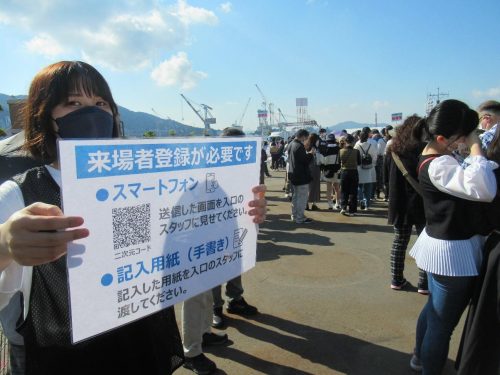
Upon passing through the admission tent, I was handed a pamphlet that indicated the locations and products for sale of the 48 vendors operating that day. On the back side was a schedule of all the events that would be occurring on stage that day; I decided which ones I insisted on watching and made sure to time my eating and ship touring sessions accordingly. Because I had a small breakfast that morning (in anticipation of all the food I would eat here), my first order of business was to grab myself a late morning snack and drink. I bought a bottle of Yamato Ramune to get into the Japanese festival mood and a box of igamochi—another Kure specialty—before situating myself at one of the tables in the eating area (standing space only). The tables were relatively vacant at the start of the Gourmet Festa but would become packed in the afternoon as more families show up to gobble up some prized naval cuisine.

In all the times I have visited Kure, this was the first time I actually tried igamochi, but I’m glad to have bought them in the morning while they were hot and fresh. Igamochi are round, white mochi made with glutinous rice, filled with mashed azuki bean paste, and covered on one end with grains of steamed rice dyed pink, yellow, or green. This box came with three igamochi (one in each color), which were all I really needed to recharge my batteries until lunch time. My purchase of the igamochi also earned me one stamp in my pamphlet; every purchase of ¥400 or more earns one stamp, and those who gather three stamps or more can enter into a drawing to win prizes (one entry for every three stamps).
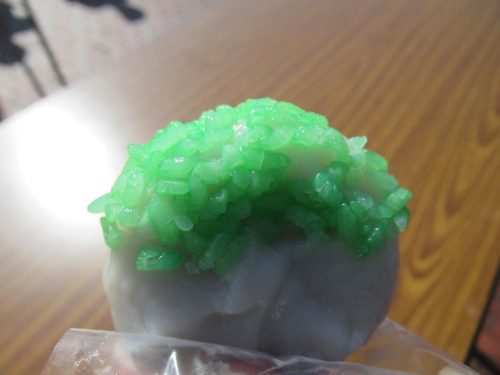
With my food and drink down the hatch, I rushed back to the central stage area to catch the first event of the day, which was the opening ceremony coupled by a concert put on by the JMSDF band. I previously had the pleasure of hearing them perform at the Kure Port Festival this past Golden Week when it rained for half a day, but this time, I got to enjoy this wonderful music in this splendid weather outside. A crowd had formed around the band while I was eating, which meant that every seat was taken, but standing near the back of the audience and reaching my camera over people’s heads still affords a decent view of the performance.
Temporary Sea Legs
After I had my fill of military symphony, it was time to board the JMSDF ship on display. I got in line where a man was holding a picket sign, and a throng of eager visitors zigged and zagged all the way to the gangway. It felt like a long while at first, but being able to hear the entertainment from the center stage made the wait more bearable. In retrospect, the line pictured above was actually on the short side, so I’m thankful to have boarded before it really got packed. Since only a certain number of people are permitted on the vessel at any given time, the line inched slowly forward, but eventually, I too made it on board.
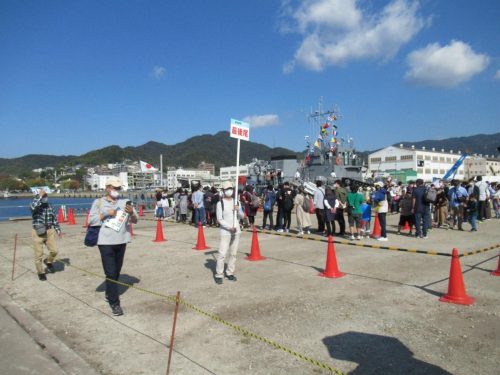
This ship is named “Hahafune 4,” and is one of six vessels that form the Explosive Ordnance Disposal Unit, a fleet that is tasked with minesweeping and other dangerous forms of maritime disposal. The ship I was touring is in charge of the waters around the Kure Naval District, and there are other such ships in Sasebo (Nagasaki Prefecture), Maizuru (Kyoto Prefecture), Yokosuka (Kanagawa Prefecture), Ominato (Aomori Prefecture), and on Okinawa Island. Navigating a corridor on the deck and climbing down a steep flight of stairs takes visitors to the above display which highlights various JMSDF ships in action, such as cleaning the sea, carrying cargo and passengers, participating in training exercises, and even engaging in combat.
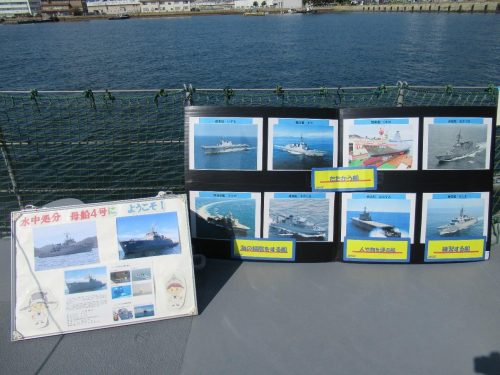
After that point, tourists proceed to the interior of the ship, where photography is forbidden, but it was just cramped quarters, a vending machine where I bought myself a drink, more stairs, and the helm. Upon entering the interior, a member of the JMSDF lets tourists sit and try on some scuba gear that the crew actually use, and since it’s super heavy, the seaman warns all tourists before they stand up. Tourists can ask to have their picture taken with their own camera if they so choose, and that’s the only photography of the ship’s interior that is allowed. After leaving the helm near the top of the ship, I came upon these fun (and free of charge) binoculars pointed toward the Akishio submarine attached to the JMSDF Museum. Following that was a path around the vessel that allowed for views of the sea, another steep staircase, one more photo opportunity with signs featuring JMSDF insignias, and the gangway off the boat.
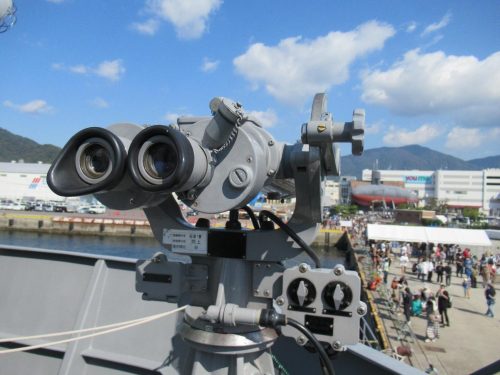
Moment of Joy: Land Ho!
Although I wasn’t going out to sea, walking around on this vessel and looking out in every direction made me feel like a sailor for just a brief moment. The top deck commanded an unmatched view of the entertainment happening on stage, and when I stuck my camera lens in front of the binoculars, I got a quirky photo like this.
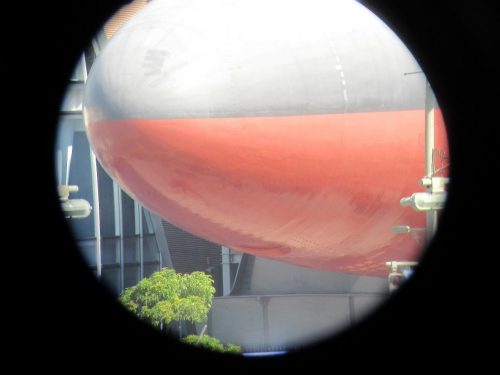
Had I been allowed; I would’ve liked to stay on this boat for an extended period just to watch the shows from way high up whilst feeling the gentle sea breeze on this fine day. Alas, lunch time was drawing near, so I disembarked and went full speed ahead to the food stands for some maritime fare.
Naval District Culinary Showdown
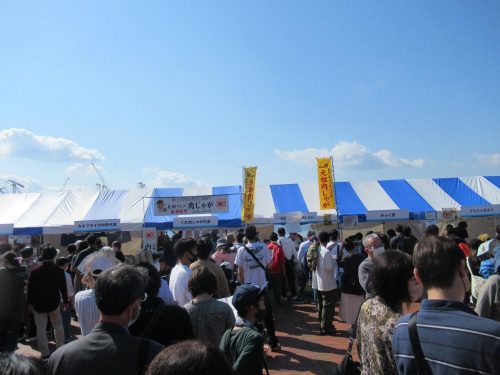
There are other stereotypical items that Japanese sailors eat besides Kaiji Curry, one of which is nikujaga (stewed meat and potatoes), and today there were two eateries side by side serving nikujaga while representing the naval districts of Kure and Maizuru. Each stand had a formidable queue, but I was determined to try both recipes to see which naval district cooks better. I bought and ate them one-by-one, but here are photos of both for easy comparison. 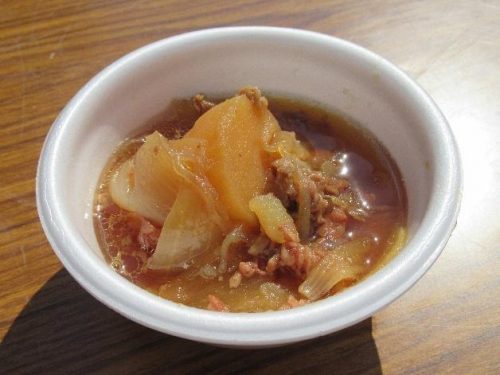
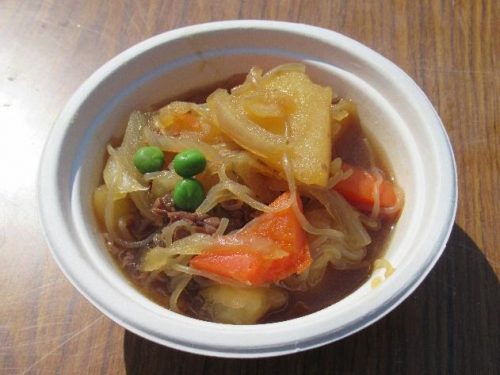
At first glance, Maizuru’s nikujaga on the right is definitely the more colorful one, but I for one don’t judge by color alone. On the left, Kure’s nikujaga tasted rich enough without the peas and carrots to liven it up, but Maizuru certainly gave Kure a run for its money. In the end, I gave the victory to Maizuru simply because more diversity in vegetables makes for a more exciting stew. Above all else, both would have tasted better in the winter, but on this hot October day (the weather doesn’t get cold until Halloween) nikujaga just wasn’t the right item to eat in the first place.
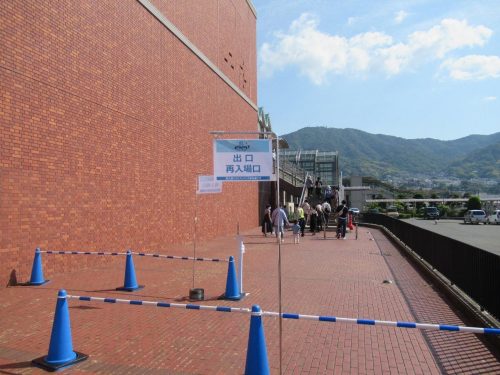
I know some of you might be thinking: who stays at a food festival for five whole hours without spending a truckload of money and/or eating until vomiting? At the back of the food zone was a garbage disposal area, and beside that was an exit and re-entry area that takes visitors back to the Yamato Museum. I took the liberty of retreating back into the YouMe Town shopping center to escape the harsh sunlight and let my body digest what I just ate before returning to the fray. Every visitor is given a wristband upon entering the event grounds; simply flash your wristband at this exit to be let back into the Gourmet Festa at any time until 3:00 p.m.
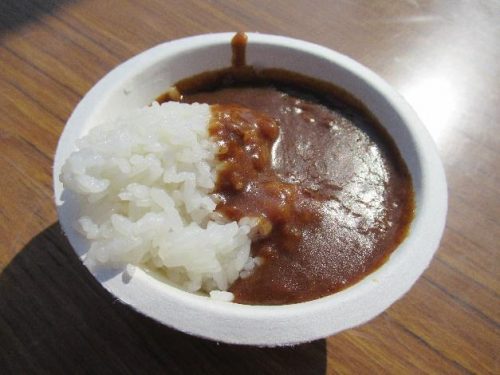
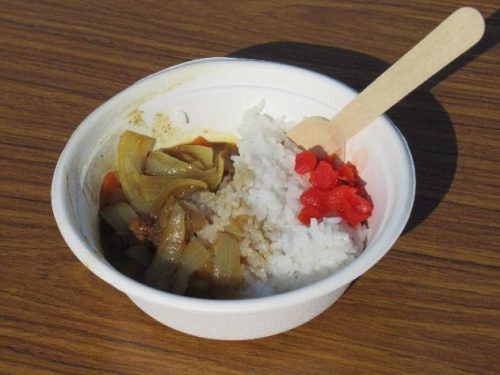
Up next was the battle of the Kaiji Curries; in the left corner we have Sasebo’s nostalgic concoction, and in the right corner we have Yokosuka’s nautical recipe. This was also around the time the shows I wanted to see were coming up, so I wolfed these down in between performances. Sasebo was generous with its roux, which was savory and more than enough for the rice, but Japanese curry enthusiasts know full well that roux alone does not a good curry make. Yokosuka with its substantial toppings took the cake, hands down, and with that, I could not longer fit another morsel in my body.
Seaside Spectaculars
The first afternoon show I wanted to catch was the JMSDF fashion exhibition, wherein various members of the JMSDF modeled the numerous uniforms worn during their day-to-day routine. They had summer uniforms, winter uniforms, ceremonial uniforms, and uniforms for specific situations like rescue missions. Then we had this pilot, who flies not for the JASDF, but takes off from JMSDF ships out at sea. He was obviously the highlight of the show and was constantly cycling through hilarious poses.
To close out the food festival, a bunch of kids dressed as “Kure-shi” put on a dance to the tune of a song meant to advertise Kure as a tourist destination. Kure-shi is a mascot of Kure, and appears to be a blue rectangle with two eyes and the kanji for Kure (呉) on his front side as well as the katakana for Kure (クレ) on his back. He was born on Marine Day some years ago, and his favorite foods are unsurprisingly Kaiji curry, nikujaga, and Kure reimen (cold noodles). After the dance number, there was a short quiz game for the kiddos in which prizes were distributed, and at the end, the MC thanked us all for coming, thus officially bringing the Kure Gourmet Festa to an end.
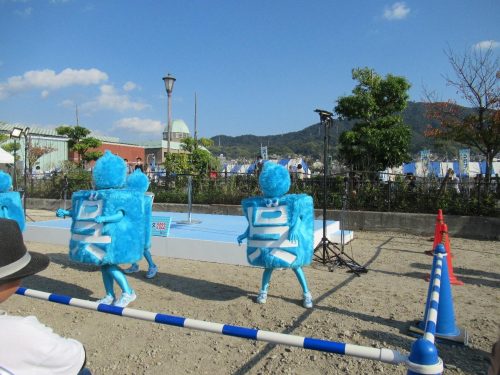
Despite the festival ending in the early afternoon, it still felt like a long day given my early start. Those who have not yet had enough of Kure for the day can spend a couple hours at the Yamato Museum or JMSDF Museum before it closes, or chill at YouMe town and grab even more bites. It’s clear that the city of Kure is trying extra hard to make its name known via events like the Kure Gourmet Festa, and the increase in PR is bound to draw even more tourists here in the future. I for one was not content with the meager amount of food I tried that day, so you can bet I’ll be back down here again and again to try all the Kaiji Curries. The world of Kaiji Curry and other naval dishes appears to be as deep as the Seto Inland Sea itself, so anyone even remotely interested in the sea or local food needs to make Kure their port of call!
Written by the Joy in Hiroshima Team
